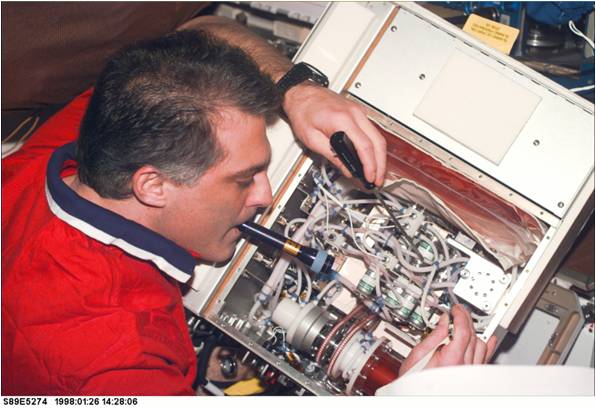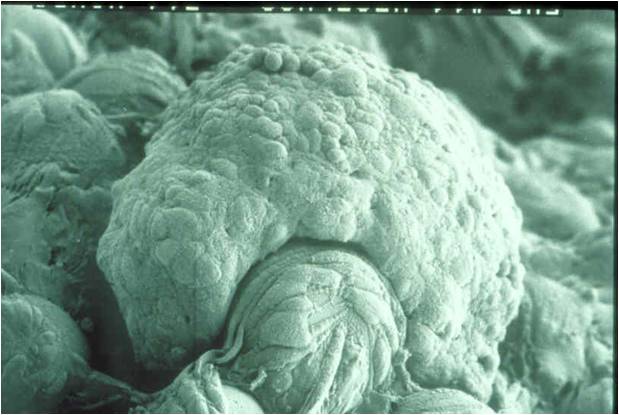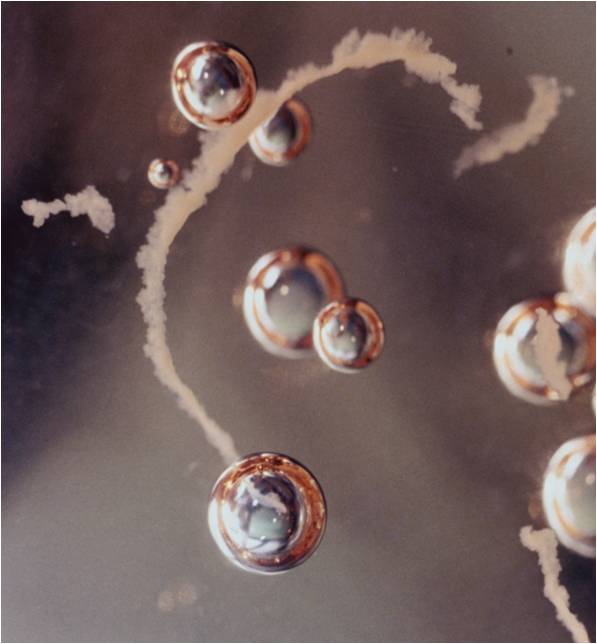This week, comments from guest blogger,medical doctor, engineer, and astronaut, Dr. David Wolf, as he reflects on tissueengineering in space.
The InternationalSpace Station National Laboratory has an edge for doing unique experiments inmedicine and biotechnology that are not possible anywhere else—we can “turnoff” gravity. As we gear up to fully use the station, the emerging field oftissue engineering is one of our high-value targets. This is a particularlypromising area of study where microgravity research has already made advancesin basic science. Indications are that further work will lead to importantapplications in clinical medicine on Earth.
Building onthe groundwork from earlier programs, biotechnology research on the spacestation, and associated ground-based research in emulated microgravity, hascreated a large body of information. This data collection demonstrates thevalue of controlled gravity systems for assembling and growing 3-Dimensional livingtissue from individual cells and substrates. The NASA-developed Space Bioreactorprovides a core in-vitro capability both in space and on Earth.

Dr. Wolf, on SpaceStation Mir, repairing a faulty valve in the Space Bioreactor,
an instrument for precisely controlling the conditions enabling the culture of 3-D
human tissues in microgravity.
(NASA image)
On Earth,these bioreactors are unique in that they are able to emulate, within limits,the far superior fluid mechanical conditions achieved in space. One may thinkof this Space Bioreactor as a 3-D petri plate. The core of the instrumentationis a rotating fluid filled cylinder, the culture vessel, producing conditionsinside resembling the buoyancy found within the womb. And much like in thehuman body, this vessel is surrounded by a life support system performing thefunctions of the heart and lung, achieving the precisely controlled conditionsnecessary for healthy tissue growth. The importance of this culturetechnique is that fluid mechanical conditions obtained in microgravity—and emulatedon Earth—allow the growth of tissues in the laboratory that cannot be grown anyother way. Emulated microgravity on Earth, and to a much greater degree, the actualmicrogravity of spaceflight enable an extremely gentle and quiescent fluiddynamic environment. The cells and substrates are free to organize into 3-Dtissues without the need to introduce disruptive suspension forces from bladesor stirring mechanisms. This leads to a broad array of applications based onenhanced in-vitro tissue culture techniques.
Theground-based versions of the Space Bioreactor produced very high fidelity colontumors for cancer research, providing strong indications of the value of actualmicrogravity, see Figure 1. Even so, when I first put space grown tissuesamples under the microscope, while aboard the Space Station Mir, I wasastounded! In my many years of experience culturing tissues, I had never seenany so well organized, so healthy, and with such fine structure. Nerve derivedtissue from the adrenal gland was forming long fronds of exceptionally delicatetissue, see Figure 2. What I was seeing could never form on Earth, even in ourstate-of-the-art systems that emulate microgravity.

Figure 1, Anartificially produced colon cancer tumor produced
under emulated microgravity on Earth is composed of millions of
cancerous cells forming a 3-D configuration, much like that
which would form in the human body. Work conducted at NASA
in collaboration with Dr. Kim Jessup.
(Image courtesy of Dr. David Wolf)
Figure 2, Neural-derivedadrenal tissue from a pheochromocytoma –
grown in actual microgravity. Photomicrograph taken by Dr. David Wolf
in work conducted on Mir in collaboration with Dr. Peter Lelkes.
(Image courtesy of Dr. David Wolf)
NASA researchin the Space Bioreactors produced over 25 U.S. patents and the technology isconsidered state-of-the-art for ground-based tissue culture. Scientists aroundthe globe from the National Institutes of Health or NIH, medical centers, and universitieshave produced numerous peer reviewed publications in highly respected journalsand even more patents based on the fundamental principles. Other actualspaceflight research has been successfully used to study breast cancer and prostatecancer. NASA has licensed its patents to spin-off companies including Synthecon, Inc., for commercialmanufacturing of the equipment, and Regenetech,Inc., for regenerative medicine and stem cell applications. These companieshave in turn sublicensed the technology even more broadly, enabling widespreaduse of this NASA-developed technology.
Researchers onEarth use this technology to study cancer, stem cells, diabetes, cartilagegrowth, nerve growth, skin, kidney, liver, heart, blood vessels, infectiousdisease—virtually every tissue in the body. The applications go much furtherthan engineering implantable tissue, to include vaccine production and living ex-vivoorganic life support systems, such as artificial livers. Researchers at the NIH,for instance, used the methods to propagate the HIV virus, responsible forAIDS, in artificial lymph node tissue—itself sustained in the bioreactor. This resultedin the ability to study the virus life cycle under controlled conditions,outside the human body.
But we arenot done. While very capable on Earth, the performance of Earth-boundbioreactors is still limited by the presence of gravity. Spaceflight testing onMir and the space shuttle demonstrate that the growth of larger, better functioning,and more organized tissue may be obtained under true low gravity conditions. Todate, the Space Bioreactor has been exploited primarily for basic research. Duringthe intervening time, the field of medicine has evolved a firm vision towardstrue regenerative tissue technology. In recent years, powerful molecular biologytechniques provided a detailed biological knowledge, which permits understandingcellular machinery almost like micro-machines. This convergence of technologywith the space station laboratory opens a new chapter for space biotechnology.
The InternationalSpace Station National Laboratory now provides an unprecedented opportunity tothe biotechnology community. Within NASA, scientists continue to work to build theinfrastructure to enable the biotechnology community; to help them take thenext steps in exploiting controlled gravity in-vitro systems. The vision is toteam together the very best minds and institutions, leveraging their abilitiesto advance regenerative medicine. Such advances can lead to improving ourquality of life on Earth and serve as a lasting legacy of the space station era.
Dr. David Wolf is anastronaut, medical doctor, and electrical engineer. Having traveled to spacefour times, Dr. Wolf participated in three short-duration space shuttlemissions and a long-duration mission to the Russian Space Station Mir. A nativeof Indianapolis, he participated in seven spacewalks, and the SLS-2 Life SciencesSpacelab Mission, logging over 4,040 hours in space. He received the NASAExceptional Engineering Achievement Medal, the NASA Inventor of the Year Award,among multiple recognitions for his work in advancing 3-D tissue engineeringtechnology.

Absolutely fantastic, folks at NASA! If you can grow tissues, maybe you can develop anticancer cells or who knows what. God bless and protect our station crews and remember people here still care about your work!
I worked with a bioreactor on the KC-135 in 2000, trying to find a way to trap and extract bubbles that form, and I assume that particular issue has been solved. I am wondering if you have any current problems that plague tissue growth in microgravity. I teach AP Chemistry and AP Biology and want to update my students on the research being done in this area.
Thank you,
Marsha Johnson
All Saints’ Episcopal School
Fort Worth, Texas
It’s great to hear mutual excitement and interest in this area of research. The presence of bubbles is not necessarily solved and the impacts to the culture may be different, depending on the culture system being used, the fluid environment, and the tissue type being cultured. Preventative controls are incorporated into hardware design and response procedures are used when the bubbles could be a detriment to the culture.
Our first tissue engineering experiment in the NASA rotating bioreactor flew on Shuttle (STS-70) and did not encounter problems with bubbles. However, during the flight of the bioreactor on Mir (NASA-Mir Increment 3), gas bubbles were observed in the bioreactor vessel starting around flight day 40. This was unexpected. Although we were unable to remove all of the bubbles from the vessel, we were able to stabilize the gas volume at about 20% and they did not appear to come in contact with the cartilage constructs. Much was learned in regards to the growth of 3-dimensional cartilage constructs and several scientific publications resulted. Despite the problems and challenges, this experiment was the first to demonstrate long-term culture of tissue constructs in space – making it a huge success.
Bubbles were not observed in the bioreactor during the following Shuttle flight (STS-85). However, returning to the Mir Space Station (NASA-Mir Increment 7) with the bioreactor on STS-89, once again, bubble formation in the vessel was observed. In this instance, different anomalies with the hardware caused the bubbles to form. One of the anomalies was caused by a faulty valve, in which you see Dr. Wolf in the photograph making repairs.
Smaller bubbles within the bioreactor vessel in microgravity may not pose a significant threat to the health of the culture. These same small bubbles if present in the vessel on Earth, will impart shear and turbulence to the culture, possibly damaging the tissue structures. It is therefore critical to remove the bubbles from the vessel. These same studies on the ground have also shown that metabolically active cultures, utilizing oxygen from the culture medium, will result in the small bubbles dissolving into the media and disappearing. With sufficient fluid volume capacitance and sufficient positive pressure in the rotating bioreactor system fluid loops, small bubbles present in the vessel in microgravity will also dissolve over time. It is important not to continually introduce new bubbles either by hardware design or by the operator.
A non-rotating configuration of hardware utilizes Teflon® bags to culture tissue constructs. These bags are permeable to gas and bubbles were observed in most instances onboard Mir (NASA-Mir Increment 6), Shuttle (STS-90), and ISS (Expeditions 3, 4, and 5). Some of the experiments conducted did not demonstrate any negative impacts to the culture as a result of the bubbles. Data from other experiments resulted in the hypothesis that bubbles present in sufficient size or quantity may impact the microenvironment, thus affecting the cultures. During ISS Expeditions 7, 8 and 10, experiments were conducted with at least one of the objectives to develop on-orbit procedures to remove the bubbles from the bags. Crew members would sling them in a way to bring the bubbles to the ports and draw them out with a syringe.
Experiments aboard the Mir Space Station had multiple objectives, including answering scientific hypotheses; and performing test and validation of hardware systems for the design and operation of future bioreactor hardware for long-term tissue engineering experiments aboard ISS.
I am glad to be a visitant of this perfect blog, appreciate it for this information
Great weblog right here! Additionally your web site lots up fast! What web host are you using? Can I get your associate link for your host? I want my website loaded up as quickly as yours lol.